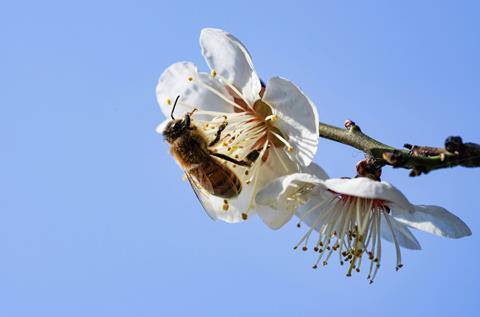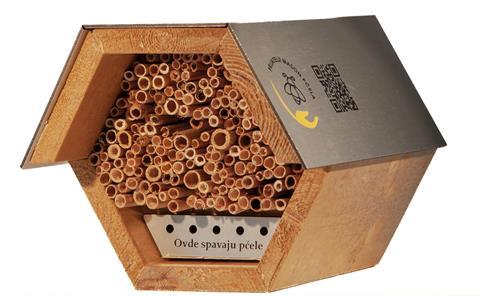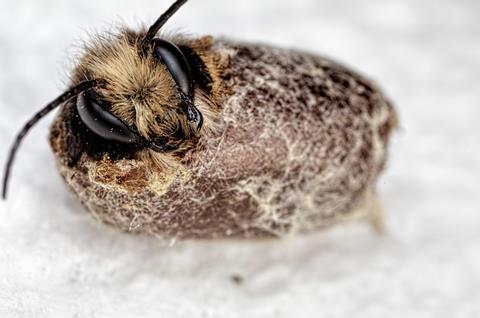Serbian entrepreneur Nela Jovic is promoting mason bee adoption across the Balkans, offering fruit producers a powerful alternative to traditional honeybee pollination

As European fruit growers grapple with declining pollinator populations and increasingly unpredictable weather patterns, a small but mighty solution is gaining traction across the continent. Mason bees – native solitary insects that excel at fruit pollination – are emerging as a valuable complement to traditional honeybee operations.
Efficiency advantage
The numbers speak for themselves: one mason bee can replace up to 120 honeybees in fruit pollination efficiency. This remarkable productivity stems from their unique biology and behavioural patterns. Unlike honeybees, which pack pollen tidily on their hind legs, mason bees are “messy eaters” that collect pollen across their hairy abdomens, making them natural pollination machines.
“Mason bees forage faster than honey bees,” explains Nela Jovic, whose Belgrade-based startup Mason Pcele is working on mason bee adoption in Serbia and neighbouring countries. “Each bee is visiting more flowers and establishing more contacts with stigmas of the visited flowers, leading to higher fruit set per visit. In addition, mason bees feed their offspring almost solely on pollen, while honey bees ‘waste time’ collecting nectar for making honey. This fundamental difference in their diet drives their superior pollination behaviour.”
The efficiency advantage also extends to weather tolerance. Mason bees are active at temperatures as low as 6C, compared to honeybees’ 12C threshold, making them invaluable during cool spring flowering periods. They’re also more tolerant of light rain and wind – crucial advantages given Europe’s increasingly variable spring weather patterns.
Proven results
A recent survey among Serbian fruit producers speaks in favour of the commercial potential of utilising mason bees. Growers reported yield improvements ranging from 10-50 per cent, with particularly dramatic results in pear and cherry orchards. Some producers of mixed fruit cultures have experienced crop increases exceeding 50 per cent.
Research validates these field observations. For example, a Spanish study demonstrated that mason bees achieved more than double the fruit set rates of honeybees in pear orchards. Likewise, numerous studies have confirmed the higher pollination performance of mason bees in sweet cherry, apple, almond and other fruit crops. Perhaps most importantly, there are studies indicating that combining mason bees with honeybees produces optimal results – achieving 70 per cent fruit set in cherries compared with just 20 per cent when either species is used alone.
Mason bees prove effective across the full spectrum of spring-blooming fruits: apples, pears, cherries, sour cherries, blueberries, plums, apricots, peaches, quinces and berries. Increased pollinator visits result in larger, more uniform fruits with extended shelf-life, affecting not only the number and amount of fruits, but also their value.
Simple implementation
Despite their sophisticated pollination capabilities, mason bees require surprisingly straightforward management. Commercial orchards typically need 1,000-5,000 bees per hectare, depending on tree age and crop type. Cherry orchards, with their abundant flower loads, generally require 2,000-3,000 bees per hectare.

The seasonal management cycle aligns well with fruit production schedules. Growers order cocoons during winter, then deploy “bee hotels” filled with reed stems or other nesting material in early spring. The stored cocoons, kept refrigerated over winter, are released when orchards begin flowering. The bees complete their two to three month active cycle, and the new cocoons (bees in the dormant stage) are harvested in late fall.
“Breeding mason bees is extremely simple, seasonal work, with the most demanding task, cocoon harvesting, conveniently happening during the slow season for fruit growers,” notes Jovic. For larger operations, rental models eliminate even this minimal management burden, with specialised beekeepers handling cocoon harvesting and storage.
Addressing climate variability
Climate change presents both challenges and opportunities for pollination management. Mason bees offer unique advantages in this evolving landscape, particularly their tolerance for adverse weather conditions that increasingly characterise European springs.
Crucially, mason bees provide growers with greater control over pollination timing. By storing mason bee cocoons, growers can use the bees ‘just-in-time’, which is a valuable tool as climate change alters traditional flowering schedules.
“You can simply keep the cocoons in the fridge and release them when your orchard is ready to be pollinated,” explains Jovic. “This is especially important since climate change can alter the time of flowering of certain plant species.”

Economic and practical considerations
The economic case for mason bees extends beyond direct yield improvements. As honeybee rental becomes more challenging – with beekeepers increasingly reluctant to move hives due to pesticide concerns and transportation stress – mason bees offer reliable pollination security.
Mason bees’ “compressed” life cycle provides additional advantages in intensive production systems. They almost complete their lifecycle by May, before major insecticide applications, while later on, their developing offspring remain protected within the nesting material.
Perhaps most importantly for commercial growers, mason bees complement rather than compete with existing honeybee operations. The species target different resources – mason bees focus on pollen while honeybees primarily collect nectar – reducing direct competition while maximising pollination efficiency.
Several large Serbian producers successfully operate integrated systems using honeybees, mason bees and bumblebees simultaneously in apple production. The key is avoiding overcrowding, particularly in monoculture environments where food resources for pollinators may be limited.
Looking forward
As precision agriculture technologies advance, mason bee deployment will become increasingly sophisticated. Future systems may incorporate predictive analytics for optimal timing and distribution, automated monitoring of pollinator activity, and integrated habitat management combining pest control, soil improvement and pollinator support. Pollinators’ biodiversity is impressive – there are over 2,000 bee species in Europe. It is expected that more species will be domesticated and used for pollinating specific crops.
“There are lots of factors influencing fruit production, and producers do not have control over many of them,” reflects Jovic. “At least for pollination there is an opportunity to use efficient agents which are easy to breed and deploy at the desired time and number.”
For European fruit growers facing pollination challenges, mason bees represent not just an alternative, but an evolution – offering precision, efficiency and reliability in an increasingly unpredictable agricultural landscape.



